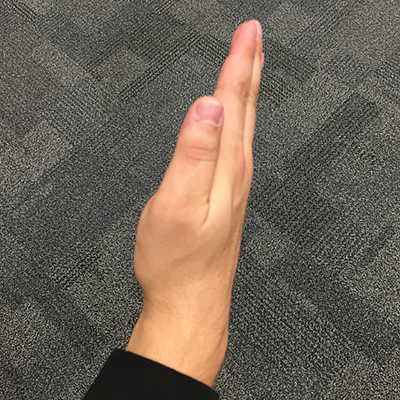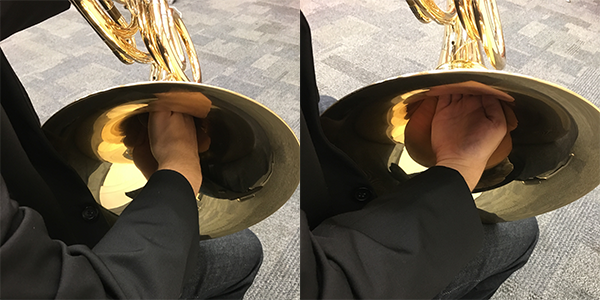
The horn is a versatile instrument, capable of making beautiful, velvety tones, while also taking on the role of strong and exciting musical characters. Yet, we seem to often have a hard time hearing the horns clearly in the midst of all the sounds coming from the band or orchestra. Horn players are faced with some unique challenges that make it difficult to project.
These include the direction of the bell (facing away from the listener), and the hand being placed inside the bell where the sound comes out. There are also additional challenges having to do with the nature of the instrument based on its design. Regardless, the issue of projection can quickly become frustrating for both directors and players. Luckily, there are ways to overcome this and help your horn section to project better!
Hand Position
The placement and position of the hand inside the bell plays a significant role in the instrument’s sound. Addressing the hand position is probably the quickest and easiest way to help your horn section project more. This will also improve the overall clarity of the sound. As a bonus, it doesn’t require much actual practice from the students – just a bit of experimenting – and you will (hopefully) hear the difference immediately!
Straighter Tends to Be Better
Sometimes young horn players have a “woofy” or muffled sound. A common cause is that their hand is covering the bell too much. For that reason, I encourage horn players to use a straight(er) hand position with little or no cupping of the hand.
Try this: Have the student put the right hand out as if they were going to shake hands. Then, have them bring the thumb over to the base knuckle of the index finger. The hand should basically be completely straight and look something like this:

Placement and Positioning
Believe it or not, the positioning/placement of the hand in the bell makes a difference in the sound. This can be a “hot topic” in the horn world, but I think it’s safe to say that we want the hand to be as out of the of way of the sound as possible. This will produce more clarity, resonance, and projection.
Once the student has the correct hand shape, have them place the hand along the right or bottom side of the bell until the base knuckle of the thumb (or first knuckle for students with larger hands) is touching the bell.

The back of the fingers should ALWAYS touch the metal of the bell. This will ensure that there is a seal inside the bell, essentially making the opening of the bell smaller, and that the hand stays “open” and out of the way of the bell opening. This will allow for better projection.
This may require some bend in the wrist in order to maintain the arm in a more comfortable position while using a straight/open hand position.
Volume – Mindset and Perspective
Horn players will almost always need to play louder than they feel is appropriate for the printed dynamic. This was one of the toughest concepts for me to grasp as a younger player! As I could usually hear myself pretty well within the ensemble, I felt like I was playing at a proper volume. It wasn’t until I played in an orchestra horn section with one of my teachers that this reality sunk in.
Six horns sat in rows, and I was right behind my teacher’s bell. The first entrance for the horns is marked fortissimo and it was in unison. My initial reaction was that my teacher, and the players in front of me, were playing much louder than I considered to be ff. However, when I listened back to a recording I was shocked to discover the volume was perfect at that moment – and it was EPIC! This really helped me understand the perspective/mindset that horn players should have when it comes to volume.
That being said, here are some ways to help your students with this concept.
Basic Mindset
Play one dynamic level louder than printed. Horn players need to be comfortable playing louder than they think is necessary! This will vary depending on the musical situation, but it’s a great starting point for establishing the mindset and perspective horn players should have in regards to volume.
Tip: I always tell students to make it a goal to get “the hand” while they are exploring this aspect of playing. It is much easier to back off when you’ve gone too far, so this is a “good problem” for them to have!
Establishing Perspective
During rehearsal, have the horn section play a passage by themselves. Invite the rest of the band to listen. Ask the individual horn players to tell you what dynamic they felt they were playing at. Then, have 2 or 3 players in different sections/areas of the band say at what dynamic level they thought the horn section played.
You might select one student that is seated close to the bell side (preferably behind or to the right of the bells), one that is to the left of the bells, and maybe one that is in front.
Finally, provide your perspective from the podium. This will not only help your horn players understand the relativity of volume/loudness from their perspectives, but will inform the players around the horn section as well. That way, once your horn section is “kicking it up a notch,” those who are bell side/right by them will (hopefully) not be influenced to play any louder than they were, resulting in better balance.
Actually Playing Louder
Sadly, loud playing often comes with bad playing habits. We all grow up hearing things like “use lots of air,” “push the air,” “squeeze/use the core muscles,” or “support your air.” Yet, when we try without truly understanding what we need to do, it leads to tension in the body and improper use of air, resulting in working too hard for a less than desirable sound. For those reasons, loud playing can be a tricky matter.
Learning to properly and easily play louder will require students to be much more conscious of HOW they are using their air and bodies. At the most basic level, it boils down to good/efficient air and body usage. Playing loud is all about figuring out how to use the appropriate amount of blowing pressure while not manipulating the body too much. This requires maintaining a proper embouchure, making sure to not use/apply excessive mouthpiece pressure, and keeping the body as relaxed as possible.
Believe it or not, this is not supposed to be super difficult! It’s important to remind your students of all of these elements when they are working toward improving this aspect of playing. While there are many ways of “teaching” students to play louder, the following are some of my favorite exercises.
Exercises
1. Blowing Against Resistance – Resistance/back pressure from the instrument often leads to tension in the body and “squeezing” or restricting the air. This air exercise can help the student to play in as relaxed a manner as possible.
2. “Blastissimos” – “Want to play loud? Practice playing loud!” Here I’m encorporating Exercise #4 from Joseph Singer’s book, Embouchure Building for French Horn.
3. “Balloon Swells” – This one will help with acquiring/improving dynamic control.
These are some of the strategies I find helpful and effective when dealing with projection. Hopefully, they’ll be helpful for your students as well!